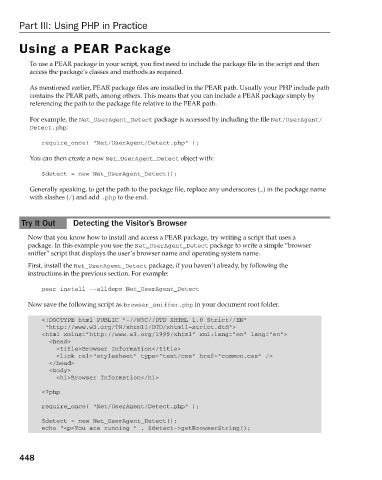Page 486 - Beginning PHP 5.3
P. 486
Part III: Using PHP in Practice
Using a PEAR Package
To use a PEAR package in your script, you first need to include the package file in the script and then
access the package ’ s classes and methods as required.
As mentioned earlier, PEAR package files are installed in the PEAR path. Usually your PHP include path
contains the PEAR path, among others. This means that you can include a PEAR package simply by
referencing the path to the package file relative to the PEAR path.
For example, the Net_UserAgent_Detect package is accessed by including the file Net/UserAgent/
Detect.php :
require_once( “Net/UserAgent/Detect.php” );
You can then create a new Net_UserAgent_Detect object with:
$detect = new Net_UserAgent_Detect();
Generally speaking, to get the path to the package file, replace any underscores ( _ ) in the package name
with slashes ( / ) and add .php to the end.
Try It Out Detecting the Visitor’s Browser
Now that you know how to install and access a PEAR package, try writing a script that uses a
package. In this example you use the Net_UserAgent_Detect package to write a simple “browser
sniffer” script that displays the user’s browser name and operating system name.
First, install the Net_UserAgent_Detect package, if you haven’t already, by following the
instructions in the previous section. For example:
pear install --alldeps Net_UserAgent_Detect
Now save the following script as browser_sniffer.php in your document root folder.
<!DOCTYPE html PUBLIC “-//W3C//DTD XHTML 1.0 Strict//EN”
“http://www.w3.org/TR/xhtml1/DTD/xhtml1-strict.dtd”>
<html xmlns=”http://www.w3.org/1999/xhtml” xml:lang=”en” lang=”en”>
<head>
<title>Browser Information</title>
<link rel=”stylesheet” type=”text/css” href=”common.css” />
</head>
<body>
<h1>Browser Information</h1>
<?php
require_once( “Net/UserAgent/Detect.php” );
$detect = new Net_UserAgent_Detect();
echo “<p>You are running “ . $detect->getBrowserString();
448
9/21/09 9:14:49 AM
c15.indd 448 9/21/09 9:14:49 AM
c15.indd 448

